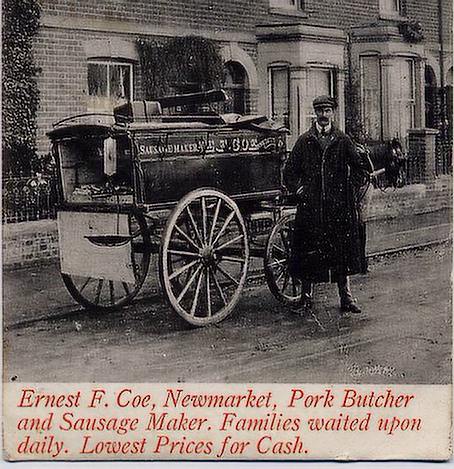Newmarket has long been famous for its delicious, quality sausages. Whether this popular, traditional food is bought from the butcher’s shop or supermarket there is little indication about how Newmarket’s sausage industry began or of the long and interesting history behind it.
East Anglia has a long tradition of rearing quality pork. Today there are still many local free-range pork farms. Certainly, Anglo-Saxon folk kept pigs, although they were a little different to those bred today, being closer in appearance to wild boar and rather hairy! There is evidence that local Anglo-Saxons grazed livestock on Newmarket Heath and pigs were undoubtedly among those animals.
Medieval folk dwelt on numerous long, narrow strip farms running out from Newmarket High Street. These tiny plots typically contained a hut-type accommodation (a hovel), some crops, a few chickens and a cow. The pigs were in a pen - or they would dig up and eat all the crops! They were fed all the waste and scraps, plus whatever could be gleaned for them locally.
Newmarket became famous for its horses, of course, from the 17th century onwards with the arrival of the Stuart Kings. Thus, its micro farms declined in favour of stables, grander accommodation and, further out of the town, the many stud farms. Food was now being transported over short distances for sale in towns and cities, so extra supplies could be brought in to supplement Newmarket’s growing needs.
However, something which did not change was the presence of pigs – now kept in stable yards. The traditional layout of old stables included a walled section in the middle of the yard into which all scraps and waste were thrown. Here the pigs did a magnificent clean-up and recycling job before unusable waste was removed for composting.
Full-grown pigs were eventually butchered to supplement the fairly poor diet available to the majority of people. Pork sausages were a relatively cheap food, but popular with poor and rich alike. Newmarket man Billy Blythe was a stable lad before the First World War, when he became a soldier and went off to fight. His diverse memories are recorded in a Newmarket Local History Society book, “A Racing Lad Steps Out”. In this Billy said of the stable pigs that all of the pig was used somehow, “Except his squeak”!
At the other end of the social catering spectrum, Musk’s received a Royal Warrant to supply King George V and his household with sausages. Musk’s still hold a Royal Warrant today. Consignments of sausages went speedily to various royal kitchens by rail, even as far as Balmoral, wherever the Royal Family was in residence. The order always included enough for the staff.
A count-up of the late 19th century Newmarket butchers’ shops from town directories reveals that there were around 19. Each produced sausages to their own, closely guarded, secret recipes. Other butchers simply traded in the weekly markets which then lined both sides of the High Street,
Newmarket sausages had achieved enormous status by then. Visitors to the races vied to get sausage supplies to take home. A type of sausage “black market” sprang up with under-the-counter deals as demand inflated prices.
Today, Newmarket Sausages, are an affordable status food with a legal Protected Geographical Indication (PGI). So, a Newmarket sausage can legally only be made in Newmarket. The Members of today’s Newmarket Sausage Association, are Powters, Musk’s and Eric Tenant Quality Butchers. Each still produces sausages from unique recipes and prime cuts of meat.
History
The Tale of Newmarket Sausages

